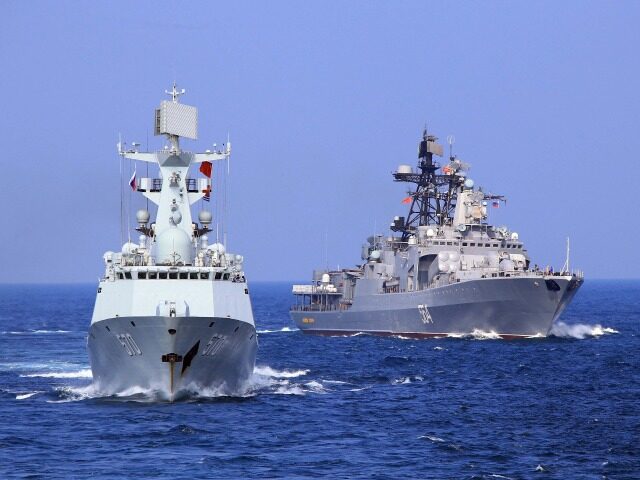The People’s Liberation Army Navy (PLAN) of China and the Russian Navy began a four-day joint military exercise in the Sea of Japan on Thursday, hilariously billed by China’s state-run Global Times as a contribution to “the safeguarding of peace and stability in Asia-Pacific amid tensions and potential threats in the region.”
Since China and Russia are the two threats everyone is worried about, the exercise probably did not settle anyone’s nerves.
The Global Times said the two militaristic authoritarian powers would practice “deterrence and repulsion, roadstead defense and mock confrontational battles,” along with live-fire drills, mock surface and submarine combat, and communications tests.
The exercise was not huge in terms of ships and planes involved, but the Chinese Communist newspaper insisted it should be regarded as a “large-scale” event because two different forces were participating with roughly comparable lineups:
At sea, the Chinese side is represented by the Type 052D guided missile destroyers Qiqihar and Guiyang, the Type 054A guided missile frigates Zaozhuang and Rizhao, and the Type 903 comprehensive replenishment ship Taihu, which rendezvoused with the Russian participating vessels, the large anti-submarine ships Admiral Tribunts and Admiral Panteleev as well as the corvettes Gremyashy and Hero of the Russian Federation Aldar Tsydenzhapov in the designated waters in the Sea of Japan on Tuesday after setting out from Qingdao, East China’s Shandong Province on Saturday.
In the air, the two countries are sending more than 30 aircraft, including fighter jets, anti-submarine aircraft and helicopters, according to the Russian press release. China Central Television reported that the Chinese side has deployed the Y-20 large transport aircraft, the KJ-500 early warning aircraft, the J-16 fighter jet and the Z-20 helicopter to Vladivostok in Russia’s Far East as part of the exercise.
“It means that Chinese aircraft are operating from Russian airfields during the exercise, marking a high level of military cooperation and mutual trust between the two countries,” Fu Qianshao, a Chinese military aviation expert, told the Global Times.
The planners of the exercise seemed very excited by the prospect of Chinese pilots growing comfortable with using Russian airfields since it would give them swifter access to the Sea of Japan. The Global Times strongly insinuated this would come in handy if China needs to attack Japan for interfering with a Chinese bid to retake Taiwan by force.
Conversely, Russian officers were invited aboard the PLAN destroyer Quiqihar to supervise the exercise, giving them experience with China’s top-shelf command-and-control systems.
Voice of America News (VOA) on Friday quoted analysts outside of China and Russia who were not thrilled by the “latest sign of deepening cooperation between the two military powerhouses,” who are obviously trying to team up and form a real challenge to the U.S. Navy in the region.
VOA’s experts said Beijing and Moscow are also interested in intimidating Japan and South Korea because China fears they might join a Pacific version of NATO.
In fact, some Chinese military bloggers said the Chinese-Russian exercise was intended as a response to a joint U.S.-Japanese-South Korean missile defense drill held earlier this week. The subject of that drill was countering North Korean missile launches, but apparently, China still found it threatening.
Taiwanese military expert Lin Ying-yu suggested China set up the Sea of Japan exercise because it is eager to learn from Russia’s expertise in fending off Ukrainian missile strikes against its Black Sea fleet.
“Scenarios from the Ukraine war may be simulated in the China-Russia joint military exercise,” Lin said, noting that China would find those scenarios relevant to its prospective invasion of Taiwan.

COMMENTS
Please let us know if you're having issues with commenting.